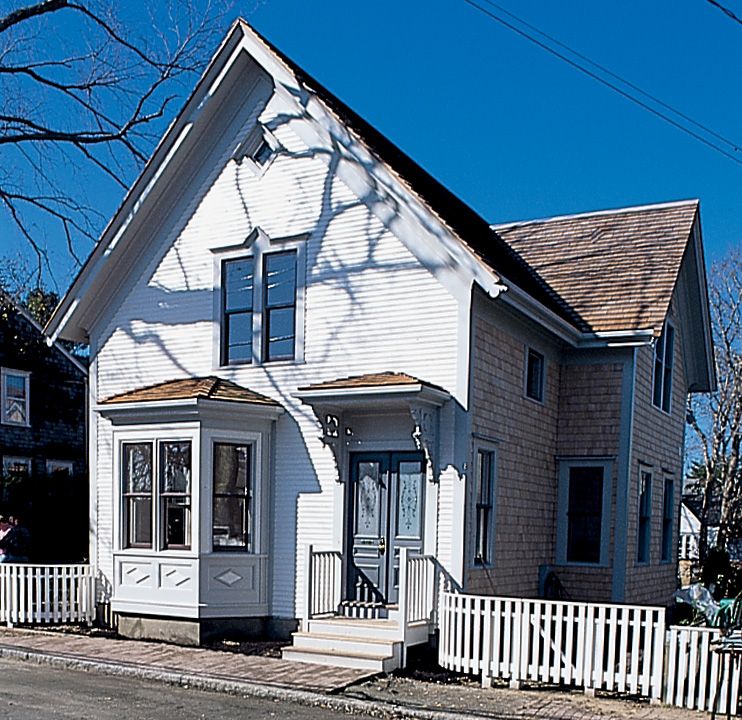“Nantucket’s appeal is that it’s more than a place, it’s a state of mind. I’m always impressed by the natural beauty which, while always under pressure, is still very much intact. Equally remarkable is the island’s man-made environment. What good fortune it is for the rest of us that generations of islanders have preserved an extensive collection of historic buildings which have become the major design influence for all new ones. The quaint, gray-weathered cottages, the fences draped with roses and the small-paned windows that typify the island’s architecture create a harmonious look that has a calming effect on those who’ve left behind a more hectic world on America… as the locals prefer to call the mainland.”
– Russell Morash, executive producer
Most people can only fantasize about someday creating their perfect island getaway. In spring and summer of 1996, we were able to bring viewers along as we escaped to the charming New England island of Nantucket, where we helped Bostonians Craig and Kathy McGraw Bentley turn their folk-style Victorian into a year-round retreat.
We were drawn to Nantucket both to cover a challenging renovation project and to tell the story of a seaside paradise preserved, but fighting to hold on to its historic character. A building boom has turned this tiny island into a microcosm of the mainland. It is grappling with all of the quality-of-life issues that larger communities across the country are facing—traffic congestion, runaway real estate prices, historic preservation and zoning versus development, land use versus environmental protection, and what to do with a landfill that’s reached capacity—but, given the island’s size, these battles seem all the more intense.
The house at 3 Milk Street was a new purchase for the Bentleys, who first visited Nantucket to attend a family gathering almost a decade ago. Smitten by its centuries-old charm and natural beauty, they had frequented the island ever since and had grown to regard it as a second home. As Kathy McGraw Bentley put it, their decision to finally establish some roots on the island was akin to what drew them there in the first place. “We’ve always loved the New England tradition of the family vacation house and bought this one with the hope of turning it into a special retreat that we could enjoy with our children and extended family for years to come—and as future place to retire,” she said.
One of only a handful of true Victorians on the island, the house stood out from its neat-as-pin, gray-shingled neighbors. Virtually untouched since it was built in 1887, the white, tired-looking house spoke of what life must have been like on one of the outermost points of New England during the latter half of the 19th century. Its windows’ simple gingerbread brackets and diamond paneling were the marks of a builder who, in his own homespun way, tried to imitate the grand Victorian architectural style that was popular on the mainland at the time. The house also told a story of frugality, as its interior was almost entirely sheathed in boards salvaged from old buildings and ships. Before the days of multi-million dollar beach houses, wood was hard to come by and Yankee thrift ruled.
This Old House took up where the original builder left off, with the goal of restoring the home’s vintage character and, at the same time, expanding and outfitting it with 1990s conveniences. Architectural designer Jock Gifford, a longtime islander, specified the most dramatic changes to the structure—two sets of two-story bump-outs that provided space for a master suite, a study/guest suite, new bathrooms, an expanded family room, and a kid’s bedroom. One of the island’s top contractors, Bruce Killen, was responsible for marrying the old with the new. In the process, he and his crew had to reinforce the house’s substandard framing to conform to current building codes, a massive job that resulted in a nickname for 3 Milk: “The house that ate wood.”
Central to the project was the replacement of the home’s antiquated systems. Perhaps the most striking technology used was a state-of-the-art geothermal heat pump that uses the earth to provide heating and cooling for the home.
Other major repairs and improvements included:
- Installing a cedar roof designed to withstand 50 years of harsh weather
- Using old photographs and some relics found in the basement to restore the entryway to its original Victorian splendor
- Weatherizing the house with an engineered insulation system
- Laying a “floating” wood floor
- Installing an in-wall bed, which allowed a downstairs room to do dual duty as a study and a guest bedroom
- Replacing the lead-paint encrusted windows with new energy-efficient ones—ones that also satisfied the guidelines imposed by the island’s Historic District Commission
- Reskinning the building in traditional clapboards and shingles, and applying a subtle three-color Victorian paint scheme
- Building a deck using ipe, a South American hardwood renowned for its durability.

